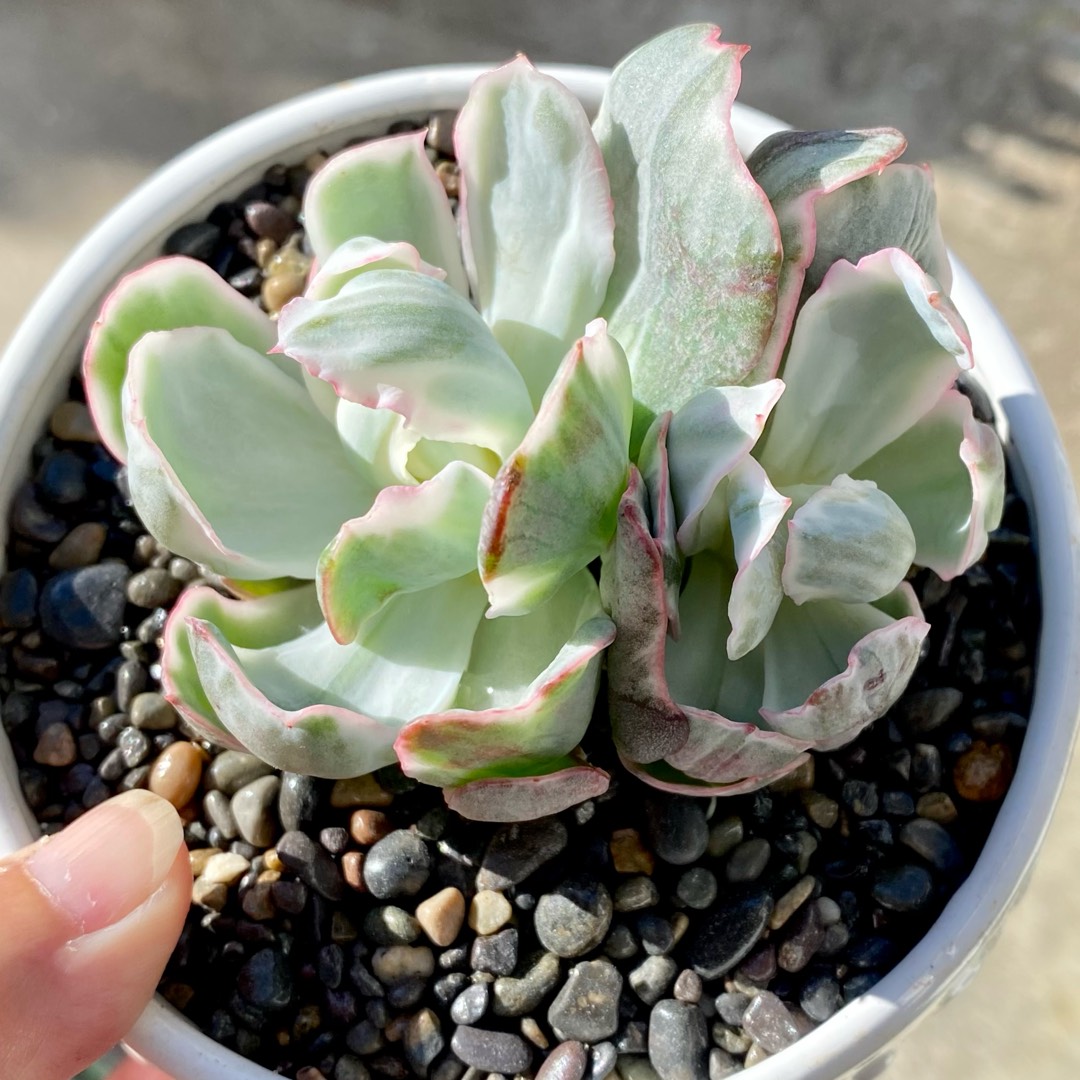
Echeveria Berkeley Variegata
Echeveria 'Berkeley Variegated Form'
Echeveria are popular low growing ornamental hobby plants. Their natural habitat is found largely in Mexico, with some from Central America, South America, the United States. Their natural habitat favours rocky areas, trees and dry areas. The species can be hugely variable, which can be either evergreen or decidious. Flowers appear on short stalks (cymes) which grow from compact rosettes with colourful foliage. Echeveria are polycarpic. This means that they may flower many times through their lifetime. Echeveria are popular host plants for butterflies and also bees. The species is drought tolerant, but do better with a little water and fertiliser. It's hybrids and cultivars tend to be less tolerant of frost, all day shade and severe sun exposure. In temperate climates, most species will lose their lower leaves in winter and become 'leggy' and less attractive. This can be prevented by still providing up to half a day sunshine or by using grow lights. Echeveria are also popular pot plants and appear in most succulent collections. They can be easily propagated by separating offsets (pups), from leaf cuttings and by growing from seed.
-
Full sun to partial shade
-
Occasional watering
-
A little frost hardy: 32F (0°C)
-
Free draining and fertile
Common name
Echeveria 'Berkeley Variegated Form'
Latin name
Echeveria Berkeley Variegata
type
Succulent
family
Crassulaceae
ph
5.5 - 6.0 Acid - Neutral
Plant & bloom calendar
-
Best time to plant
-
When the plant will bloom
full grown dimensions
 0.15 M
0.15 M
0.15 M
0.15 M
Echeveria Berkeley Variegata
Echeveria are popular low growing ornamental hobby plants. Their natural habitat is found largely in Mexico, with some from Central America, South America, the United States. Their natural habitat favours rocky areas, trees and dry areas. The species can be hugely variable, which can be either evergreen or decidious. Flowers appear on short stalks (cymes) which grow from compact rosettes with colourful foliage. Echeveria are polycarpic. This means that they may flower many times through their lifetime. Echeveria are popular host plants for butterflies and also bees. The species is drought tolerant, but do better with a little water and fertiliser. It's hybrids and cultivars tend to be less tolerant of frost, all day shade and severe sun exposure. In temperate climates, most species will lose their lower leaves in winter and become 'leggy' and less attractive. This can be prevented by still providing up to half a day sunshine or by using grow lights. Echeveria are also popular pot plants and appear in most succulent collections. They can be easily propagated by separating offsets (pups), from leaf cuttings and by growing from seed.
Planting
From Early Spring TO Late Winter
Echeveria can be propagated easily by separating pups, but also by leaf cuttings, and by seed. It needs a warm, sunny position with well drained soil to develop their foliage colour. It is recommended to position plants in an area where they are in part shade. This means that they should be in morning sun, or afternoon sun, or both (but shaded during the harsh midday period). Alternatively, plants may be grown under full filtered sun underneath shade cloth which is usually stocked by your local hardware store. 50% filtration is recommended to avoid sunburn but maintain great colour. You may need to test what works well in your particular climate. Most succulents will be grown in containers and pots and they will need good drainage medium. Add coarse grit such as perlite or pumice to soil and repot every year in late-spring. Don't worry about damaging the roots when re-potting as most Echeveria generally tolerate disturbance well.
Flowering
From Early Spring TO Late Winter
Echeveria could flower a number of times through the year. Flowering can use much of the plant’s energy, therefore it’s recommended that flower stalks are removed from sick or weaker plants until they are well established. If your plant is healthy, enjoy it’s beautiful show of blooms. Flowers on short stalks (cymes) arise from compact rosettes of succulent's fleshy, often brightly coloured leaves. Species are polycarpic, meaning that they may flower and set seed many times over the course of their lifetimes and indeed a number of times per year.
Propagating
From Early Spring TO Late Winter
Pluck a leaf gently from the stem taking care not to damage the leaf. It should have a u-shape if plucked correctly. Leave the leaf for a few days to callous over. Once this has happened, place the leaf on top of your propagation medium of choice with the u-shaped end downward, rest the leaf on a bamboo stick or similar at a 45 degree angle to the propagation medium. Propagation is best done in indirect light, not in direct sunlight. Alternatively, a grow light can be used. Roots should sprout in two to four weeks, followed by new tiny leaves. At this point, depending on the humidity and rainfall in your area, you may mist or lightly water your leaves as the plant grows. Resist the urge to remove the mother leaf once it becomes dried up and shrivelled. It’s best for this process to occur naturally.















